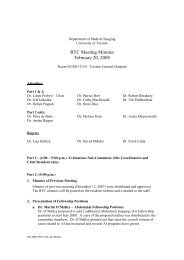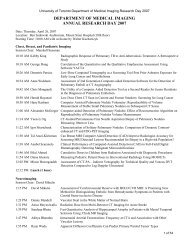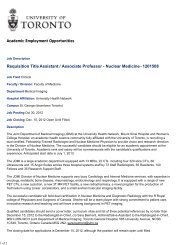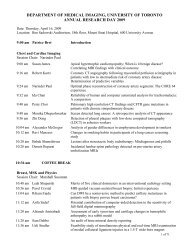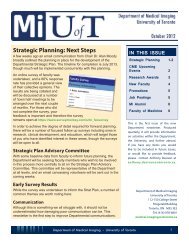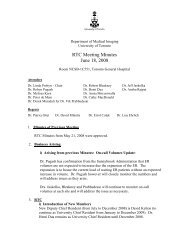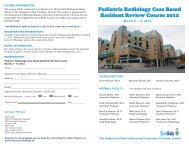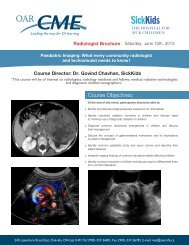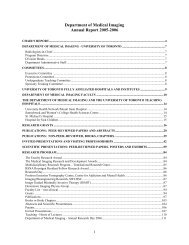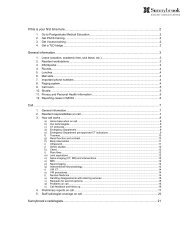Differentiation of Simple and Strangulated Small-Bowel Obstructions ...
Differentiation of Simple and Strangulated Small-Bowel Obstructions ...
Differentiation of Simple and Strangulated Small-Bowel Obstructions ...
Create successful ePaper yourself
Turn your PDF publications into a flip-book with our unique Google optimized e-Paper software.
Hyun K. Ha, MD #{149} Jin S. Kim, MD #{149} Moo S. Lee, MD #{149} Hong J. Lee, MD #{149} Yoong K. Jeong, MD<br />
Pyo N. Kim, MD #{149} Moon C. Lee, MD #{149} Kee W. Kim, MD #{149} Mi Y. Kim, MD #{149} Yong Ho Auh, MD<br />
<strong>Differentiation</strong> <strong>of</strong> <strong>Simple</strong> <strong>and</strong> <strong>Strangulated</strong><br />
<strong>Small</strong>-<strong>Bowel</strong> <strong>Obstructions</strong>: Usefulness<br />
<strong>of</strong> Known CT Criteria’<br />
PURPOSE: To evaluate the usefulness<br />
<strong>of</strong> known computed tomographic<br />
(CT) criteria for the differentiation <strong>of</strong><br />
simple <strong>and</strong> strangulated small-bowel<br />
obstructions.<br />
MATERIALS AND METHODS: CT<br />
scans <strong>of</strong> 84 patients with simple (n<br />
43) <strong>and</strong> strangulated (n = 41) smallbowel<br />
obstructions caused by adhesions,<br />
hernia, <strong>and</strong> volvulus were reviewed<br />
retrospectively. Diagnoses<br />
were made with surgery (n 55) <strong>and</strong><br />
during clinical follow-up (n 29).<br />
CT criteria evaluated were configuralion<br />
<strong>of</strong> obstructed bowel ioop, target<br />
sign, bowel wall thickening <strong>and</strong> enhancement,<br />
changes in mesentery<br />
<strong>and</strong> mesenteric vasculature, <strong>and</strong><br />
amount <strong>and</strong> attenuation <strong>of</strong> ascites.<br />
RESULTS: CT findings that enabled<br />
the detection <strong>of</strong> strangulated obstructions<br />
were poor or no enhancement<br />
<strong>of</strong> bowel wall (sensitivity, 34%;<br />
specificity, 100%) <strong>and</strong> a serrated beak<br />
(sensitivity, 32%; specificity 100%).<br />
When these two findings were excluded<br />
from analysis, a large amount<br />
<strong>of</strong> ascites, an unusual course <strong>of</strong> mesenteric<br />
vasculature, <strong>and</strong> diffuse engorgement<br />
<strong>of</strong> mesenteric vasculature<br />
were shown to be useful CT findings<br />
for performing multivariate regression<br />
analysis. Application <strong>of</strong> these<br />
five CT findings enabled identification<br />
<strong>of</strong> 35 (85%) <strong>of</strong> 41 patients with<br />
strangulated obstructions.<br />
CONCLUSION: Detecting a combination<br />
<strong>of</strong> selected, known CT criteria<br />
increases the diagnostic accuracy <strong>of</strong><br />
CT to enable differentiation <strong>of</strong> simple<br />
<strong>and</strong> strangulated small-bowel obstructions.<br />
Abdominal <strong>and</strong> Gastrointestinal Radiology<br />
S IMPLE <strong>and</strong> strangulated smallbowel<br />
obstructions are distinguished<br />
by the respective absence or<br />
presence <strong>of</strong> impaired vascular circulalion<br />
to the obstructed intestine. Their<br />
differentiation is one <strong>of</strong> the principal<br />
diagnostic problems for physicians<br />
who treat patients with small-bowel<br />
obstructions. Various findings on abdominal<br />
CT images aid the diagnosis<br />
<strong>of</strong> advanced bowel strangulation, yet<br />
its early detection is <strong>of</strong>ten problematic.<br />
Many reports <strong>of</strong> studies stress<br />
the importance <strong>of</strong> noting mesenteric<br />
changes, configuration <strong>of</strong> obstructed<br />
bowel loop, or contrast enhancement<br />
patterns <strong>of</strong> the bowel wall on CT images<br />
(1-8). However, the lack <strong>of</strong> control<br />
groups in these studies potentially<br />
renders these CT findings less specific<br />
<strong>and</strong> reliable (9). These findings may<br />
also appear on CT scans <strong>of</strong> patients<br />
with inflammatory bowel diseases,<br />
gastrointestinal neoplasms, or paralytic<br />
ileus; they may even appear on<br />
CT images <strong>of</strong> healthy subjects. Furthermore,<br />
some <strong>of</strong> the CT findings<br />
that were considered to be highly suggestive<br />
<strong>of</strong> strangulated small-bowel<br />
obstruction have been seen on images<br />
<strong>of</strong> simple obstruction (4). To ascertain<br />
the diagnostic value <strong>of</strong> known CT criteria<br />
<strong>of</strong> small-bowel strangulation, a<br />
study that compares findings on CT<br />
scans <strong>of</strong> a large number <strong>of</strong> patients<br />
with simple <strong>and</strong> strangulated smallbowel<br />
obstructions is necessary.<br />
The purpose <strong>of</strong> this study was to<br />
evaluate the usefulness <strong>of</strong> known CT<br />
Index terms: Intestines, C’I 748.12112 #{149} Intestines, stenosis or obstruction, 748.723, 748.724<br />
Radiology 1997; 204:507-512<br />
criteria for identifying small-bowel<br />
strangulation in a large series <strong>of</strong> 84<br />
patients with simple or strangulated<br />
small-bowel obstructions caused by<br />
adhesions, hernia, or volvulus.<br />
MATERIALS AND METHODS<br />
A computerized search was conducted<br />
at two institutions for cases from January<br />
1991 to March 1996 <strong>of</strong> small-bowel obstructions<br />
caused by adhesions, hernia, or volvulus<br />
in patients who had undergone<br />
surgery before developing small-bowel<br />
obstruction. Of 450 patients identified, 173<br />
had undergone CT for evaluation <strong>of</strong> their<br />
small-bowel obstructions. However, 89<br />
<strong>of</strong> these patients were excluded from the<br />
study because <strong>of</strong> the following: CT scans<br />
were not available (n = 15), small-bowel<br />
obstructions were caused by malignant<br />
(n = 35) or inflammatory (n = 23) lesions,<br />
contrast material was not given intravenously<br />
during the CT examination (n = 6),<br />
or findings on CT scans reviewed did not<br />
meet criteria for those <strong>of</strong> small-bowel obstruction<br />
(n = 10) (2,10). The study population,<br />
therefore, consisted <strong>of</strong> 84 consecutively<br />
evaluated patients with simple (n<br />
43) or strangulated (n = 41) small-bowel<br />
obstructions whose Cr were reviewed<br />
retrospectively. Patient ages ranged from<br />
19 to 83 years (mean, 49 years). There<br />
were 40 women <strong>and</strong> 44 men.<br />
Before developing obstruction, all patients<br />
had undergone surgery for the following:<br />
inflammatory bowel disease (n<br />
20), gastric or colon cancer (ii 19), gynecologic<br />
disease (n = 20), hepatobiliary disease<br />
(n = 13), <strong>and</strong> other conditions (n = 12).<br />
Of these 84 patients, 55 underwent surgery<br />
again because they exhibited clinical<br />
I From the Departments <strong>of</strong> Radiology (H.KH.,J.S.K., H.J.L, Y.K.J., P.N.K., M.G.L, Y.H.A.) <strong>and</strong> Pre-<br />
ventive Medicine (MS.L), Man Medical Centei University <strong>of</strong> Ulsan Medical College, 388-1 Poongnap-<br />
Dong, Songpa-Ku, Seoul 138-040, Korea; Department <strong>of</strong> Radiology, Yongdong Severance Hospital,<br />
Yonsei University Seoul, Korea (K.W.K.); <strong>and</strong> Department <strong>of</strong> Radiology, Inha University Hospital,<br />
Kyunggi-do, Korea (M.Y.K.). From the 1996 RSNA scientific assembly. Received November 5, 1996;<br />
revision requested December 20; revision received March 6, 1997; accepted March 17. Address reprint<br />
requests to H.K.H.<br />
C RSNA, 1997<br />
507
signs <strong>and</strong> symptoms <strong>of</strong> small-bowel strangulation<br />
or did not respond favorably to<br />
conservative treatment; they underwent<br />
simple adhesiotomy (n = 21) or segmental<br />
bowel resection (n = 34) to relieve the obstruction.<br />
Obstruction was confirmed during<br />
surgery in all 55 patients; 41 had strangulated<br />
obstructions <strong>and</strong> 14 had simple<br />
obstructions. <strong>Obstructions</strong> were caused by<br />
adhesions or b<strong>and</strong>s (n = 43), hernia (n =<br />
9), or volvulus (ri = 3). The time between<br />
surgery <strong>and</strong> CT ranged from a few hours<br />
to 13 days (mean, 2 days); for 31 patients,<br />
it was less than or equal to 1 day.<br />
In the other 29 patients, obstructions improved<br />
with fluid <strong>and</strong> electrolyte replacement<br />
<strong>and</strong>/or after the insertion <strong>of</strong> a nasogastric<br />
tube for 2-11 days (mean, 5 days)<br />
for decompression; in seven <strong>of</strong> these 29<br />
patients, long decompression tubes were<br />
used. Although not confirmed with surgeny,<br />
the obstructions <strong>of</strong> 14 <strong>of</strong> these 29 patients<br />
were diagnosed with small-bowel<br />
follow-through examinations: complete<br />
obstruction, two patients; high-grade partial<br />
obstruction, eight patients; <strong>and</strong> lowgrade<br />
partial obstruction, four patients.<br />
With use <strong>of</strong> CT criteria proposed by<br />
Fukuya et al (10) <strong>and</strong> Gazelle et al (11),<br />
findings consistent with small-bowel obstruction,<br />
<strong>and</strong> not paralytic ileus, were<br />
seen on the CT scans <strong>of</strong> 10 <strong>of</strong> the other 15<br />
patients. Diffuse small-bowel dilatation<br />
(luminal diameter, 3.5 cm) <strong>and</strong> collapsed<br />
distal small bowel, colon, on both were<br />
seen on the CT scans <strong>of</strong> these 10 patients.<br />
On the CT scans <strong>of</strong> the other five patients,<br />
small-bowel loops with luminal diameters<br />
less than 3.5 cm but greater than 3.0 cm<br />
were seen. The plain abdominal radiographs<br />
<strong>of</strong> these five patients, obtained<br />
within 1 week before CT, revealed findings<br />
typical <strong>of</strong> small-bowel obstruction (distended<br />
fluid-filled proximal loops, multiple<br />
step-ladder patterns <strong>of</strong> air-fluid 1evels,<br />
<strong>and</strong> collapsed distal small-bowel,<br />
colon, or both).<br />
We considered these 29 patients to have<br />
simple small-bowel obstruction. To support<br />
the belief that these patients did not<br />
have strangulated obstruction, the number<br />
<strong>of</strong> the following clinical features in these<br />
29 patients was compared with that in the<br />
41 patients with strangulated obstruction:<br />
abdominal tenderness, tachycardia (heart<br />
rate, > 100 beats per minute), fever (ternperature,<br />
>38.5#{176}C),<strong>and</strong> leukocytosis (white<br />
blood cell count, >10,000/mr& [10.0 X<br />
109/LJ). Of the 41 patients with strangulated<br />
obstruction, 12 patients had all four<br />
features, 10 had three, 16 had two, <strong>and</strong><br />
three had one. Of the 29 patients with<br />
simple obstruction, four patients had two<br />
<strong>of</strong> the features, 15 had one, <strong>and</strong> 10 had<br />
none.<br />
CT was performed with a GE 9800<br />
Quick System, a HiLight Advantage (GE<br />
Medical Systems, Milwaukee, Wis), or a<br />
Somatom Plus-S (Siemens, Erlangen, Germany)<br />
scanner. Sections <strong>of</strong> 8- or 10-mm<br />
thickness were imaged from the diaphragm<br />
to the pubis at intervals <strong>of</strong> 8 or 10 mm.<br />
Contrast material (500-800 mL; E-Z-CAT,<br />
2% iodinated, water soluble; E-Z-Em,<br />
Westbury, NY) was given orally 30 mm-<br />
Table 1<br />
Findings on CT Scans<strong>of</strong> 84 Patients with <strong>Strangulated</strong> or <strong>Simple</strong> Obstruction<br />
CT Findings<br />
<strong>Strangulated</strong><br />
(n = 41)<br />
<strong>Simple</strong><br />
(n = 43)<br />
<strong>Bowel</strong> wall changes<br />
Smootltserrated beak 5:13 26:0<br />
Target sign 12 3<br />
Wall thidmess (mean ± SD, mm) 5.1 ± 2.1 3.5 ± 1.0<br />
1. #{163};1<br />
Table 2<br />
Diagnostic Value <strong>of</strong> CT Findings for the Detection <strong>of</strong> <strong>Small</strong>-<strong>Bowel</strong> Strangulation in<br />
84 Patients<br />
CT Findings Sensitivity SpeCifiCity P Value<br />
Poor or no contrast enhancement 34 100
er <strong>of</strong> these findings on the CT scans<br />
<strong>of</strong> the 43 patients with simple obstruction<br />
were the following: no findings,<br />
38 patients (88%) <strong>and</strong> one finding, five<br />
patients (12%). The CT findings <strong>of</strong><br />
these five patients consisted <strong>of</strong> an unusual<br />
course <strong>of</strong> mesentenic vasculature<br />
(n = 2), diffuse mesenteric changes (n =<br />
2), <strong>and</strong> a large amount <strong>of</strong> ascites (n = 1).<br />
Interobserver agreement was excellent<br />
for the identification <strong>of</strong> the target<br />
sign (K = 0.76), poor on no contrast<br />
enhancement <strong>of</strong> the bowel wall (K =<br />
0.88), a small amount <strong>of</strong> ascites (K =<br />
0.79), <strong>and</strong> a large amount <strong>of</strong> ascites<br />
(K 0.83). It was good for the identification<br />
<strong>of</strong> a smooth beak (K = 0.61), a<br />
serrated beak (K 0.53), an unusual<br />
course <strong>of</strong> mesenteric vasculatune (K =<br />
0.56), focal engongement <strong>of</strong> mesentenic<br />
vasculature (K 0.63), focal haziness<br />
<strong>of</strong> the mesentery (K = 0.64), diffuse<br />
engorgement <strong>of</strong> the mesenteric vasculature<br />
(K = 0.69), diffuse haziness <strong>of</strong><br />
the mesentery (K 0.67), mesentenic<br />
vascular thrombosis (K = 0.55), <strong>and</strong><br />
high attenuation <strong>of</strong> ascites (K = 0.63).<br />
DISCUSSION<br />
An underst<strong>and</strong>ing <strong>of</strong> the basic<br />
pathophysiologic processes <strong>of</strong> smallbowel<br />
strangulation is important because<br />
CT findings are closely associated<br />
with secondary changes in the<br />
bowel wall, mesentery, <strong>and</strong> penitoneal<br />
cavity. Three phenomena usually occur<br />
together in small-bowel strangulation:<br />
mechanical obstruction that is<br />
proximal to the involved bowel segment,<br />
closed-loop obstruction <strong>of</strong> the<br />
involved bowel segment, <strong>and</strong> venous<br />
congestion <strong>of</strong> the involved bowel loop<br />
(14). Initially, venous return <strong>of</strong> blood<br />
from the involved bowel segment is<br />
compromised while influx <strong>of</strong> arterial<br />
blood continues; this leads to engorgement<br />
<strong>and</strong> distension <strong>of</strong> vessels, frank<br />
hemorrhage into the bowel lumen or<br />
wall, <strong>and</strong> exudation <strong>and</strong> transudation<br />
<strong>of</strong> fluid across the senosa into the pentoneal<br />
cavity (15). Although the CT<br />
criteria (1-4) we used largely reflect<br />
these pathophysiologic processes, the<br />
different frequencies <strong>of</strong> each CT finding<br />
seem to result from the different<br />
primary causes <strong>and</strong> seventies <strong>of</strong> the<br />
obstructions. There are also no data<br />
that describe precisely the sequential<br />
changes <strong>of</strong> the CT findings <strong>of</strong> strangulation<br />
or how these findings are useful<br />
for enabling the diagnosis <strong>of</strong> strangulation.<br />
According to several researchers<br />
(1-4,16,17), CT findings <strong>of</strong> slight thickening<br />
<strong>of</strong> the bowel wall, the target<br />
sign, engorgement <strong>of</strong> the mesentenic<br />
vasculatune, <strong>and</strong> mesentenic edema<br />
4.-.<br />
3. 4.<br />
Figures 3, 4. (3) <strong>Strangulated</strong> small-bowel obstruction caused by adhesions in a 45-year-old<br />
man. Contrast-enhanced CT scan <strong>of</strong> the abdomen shows a serrated beak (arrows) in the bowel<br />
loop at the site <strong>of</strong> obstruction. There is diffuse haziness <strong>and</strong> vascular engorgement in the regional<br />
mesentery (arrowheads). (4) <strong>Strangulated</strong> small-bowel obstruction caused by adhesions<br />
in a 70-year-old woman. Contrast-enhanced CT scan <strong>of</strong> the pelvis shows a fluid collection (F)<br />
in the pelvic cavity that is hyperattenuating compared with fluid in the bowel loop.<br />
‘%/#<br />
5. 6.<br />
Figures 5, 6. (5) <strong>Strangulated</strong> small-bowel obstruction caused by volvulus in a 28-year-old<br />
man. Contrast-enhanced CT scan <strong>of</strong> the abdomen shows mesenteric vessels converging into<br />
the site <strong>of</strong> obstruction (arrow). A fluid collection is present in the peritoneal cavity. (6) <strong>Strangulated</strong><br />
small-bowel obstruction caused by adhesive b<strong>and</strong>s in a 46-year-old man. Contrastenhanced<br />
CT scan <strong>of</strong> the abdomen shows diffuse segmental haziness <strong>of</strong> the mesentery (*).<br />
are early or reversible signs <strong>of</strong> smallbowel<br />
strangulation, whereas bowel<br />
infarction on gangrene is indicated<br />
with CT findings <strong>of</strong> high attenuation<br />
<strong>of</strong> the bowel wall, pneumatosis, hemorrhagic<br />
changes in the mesentery, gas<br />
in the portal vein, <strong>and</strong> poor or no enhancement<br />
<strong>of</strong> the bowel wall.<br />
In a recent report, Frager et al (6)<br />
stated that on CT scans there was no<br />
completely specific preoperative indicaton<br />
<strong>of</strong> strangulation in patients with<br />
small-bowel obstruction caused by<br />
hernias or adhesions. This suboptimal<br />
specificity <strong>of</strong> CT was attributed mainly<br />
to the subjective interpretation <strong>of</strong> various<br />
ischemic signs on CT scans (without<br />
the use <strong>of</strong> CT scans <strong>of</strong> a control group<br />
with other diseases) <strong>and</strong> problems <strong>of</strong><br />
inspecting affected bowel during sungery.<br />
However, as our study demonstrated,<br />
some <strong>of</strong> the CT findings-if<br />
one is attempting to differentiate simple<br />
<strong>and</strong> strangulated small-bowel<br />
obstructions-had very high specificities.<br />
These CT findings were poor or<br />
no enhancement <strong>of</strong> the bowel wall, a<br />
serrated beak, diffuse engorgement <strong>of</strong><br />
mesenteric vasculature or mesentenic<br />
haziness, an unusual course <strong>of</strong> mesentenic<br />
vasculature, <strong>and</strong> a large amount<br />
<strong>of</strong> ascites.<br />
When compared to results <strong>of</strong> prior<br />
studies (1-8), the results <strong>of</strong> our blinded<br />
reinterpretation <strong>of</strong> the CT scans <strong>of</strong> a<br />
large number <strong>of</strong> patients show that<br />
most <strong>of</strong> the known CT criteria, when<br />
used alone, are not sensitive indicatons<br />
<strong>of</strong> simple or strangulated smallbowel<br />
obstruction (Tables 1-3). The<br />
CT scans <strong>of</strong> 19 (46%) <strong>of</strong> the 41 patients<br />
with surgically proved strangulation<br />
showed bowel-wall thickening <strong>of</strong> less<br />
than 5 mm, scans <strong>of</strong> 27 patients (66%)<br />
showed normal bowel-wall enhancement,<br />
<strong>and</strong> scans <strong>of</strong> 29 patients (71%)<br />
showed no target sign. Even three <strong>of</strong><br />
the five highly specific CT findings<br />
510 #{149} Radiology August 1997
7. 8. 9.<br />
Figures 7-9. (7) <strong>Strangulated</strong> small-bowel obstruction owing to incisional hernia in a 38-year-old man. Contrast-enhanced CT scan <strong>of</strong> the abdomen<br />
shows prolonged enhancement <strong>of</strong> thickened bowel wall in the herniated, strangulated segment (Ii). There are fluid collections in the hernia<br />
sac <strong>and</strong> right paracolonic gutter. (8) <strong>Simple</strong> obstruction caused by adhesive b<strong>and</strong>s in a 38-year-old man. Contrast-enhanced CT scan <strong>of</strong> the<br />
abdomen shows diffuse dilatation <strong>of</strong> a small-bowel loop with the target sign. The obstructed site (arrow) shows a smooth beak configuration.<br />
(9) <strong>Simple</strong> obstruction caused by adhesions in a 60-year-old man. Contrast-enhanced CT scan <strong>of</strong> the abdomen shows multiple dilated smallbowel<br />
loops <strong>and</strong> focal engorgement <strong>of</strong> the mesentenic vasculature (arrows) next to the obstructed site.<br />
Table 3<br />
Diagnostic Value <strong>of</strong> CT Findings for the Detection <strong>of</strong> <strong>Small</strong>-<strong>Bowel</strong> Strangulation in<br />
61 Patients<br />
CT Findings Sensitivity SpecifiCity P Value<br />
Large amount <strong>of</strong> ascites 22 98 .024<br />
Diffuse mesenteric haziness 39 98 .005<br />
Diffuse engorgement <strong>of</strong> MV* 50 95
greatly aids the diagnosis <strong>of</strong> smallbowel<br />
strangulation (15). The high<br />
attenuation <strong>of</strong> ascites on CT images<br />
<strong>of</strong> strangulated obstruction is probably<br />
caused by increased protein content<br />
in the fluid. However, in our study,<br />
the attenuation <strong>of</strong> ascites was cornpared<br />
with that <strong>of</strong> bile in the gallbladder<br />
or cysts in the liver or kidney, <strong>and</strong><br />
images <strong>of</strong> both simple <strong>and</strong> strangulated<br />
obstructions revealed hyperattentuating<br />
asdtes. Since a large amount<br />
<strong>of</strong> ascites may be caused by many<br />
conditions, confirmation <strong>of</strong> other CT<br />
findings in the mesentery or bowel is<br />
required so that the diagnosis <strong>of</strong> strangulation<br />
is not made incorrectly.<br />
We defined the mesenteric changes<br />
(haziness or vascular engorgement) as<br />
focal or diffuse because these changes<br />
may be observed on CT images <strong>of</strong> patients<br />
with simple small-bowel obstruction.<br />
As expected, focal mesenteric<br />
changes were seen on CT images<br />
<strong>of</strong> both simple <strong>and</strong> strangulated obstructions<br />
(Fig 9). Diffuse mesenteric<br />
changes, however, had high specificities<br />
(>95%) for the detection <strong>of</strong> strangulation.<br />
An unusual course <strong>of</strong> mesenteric<br />
vasculature (indicated with a<br />
reversed position <strong>of</strong> superior mesenteric<br />
artery <strong>and</strong> vein, the whirl sign,<br />
or convergence <strong>of</strong> vessels) has been<br />
seen also in cases <strong>of</strong> closed-loop obstruction<br />
(1,2,8) or malrotation (21).<br />
Although further study is necessary,<br />
some <strong>of</strong> these findings may be seen<br />
on CT scans <strong>of</strong> asymptomatic patients.<br />
Furthermore, strangulation does not<br />
always occur in patients with closedloop<br />
obstruction. Therefore, this finding-an<br />
unusual course <strong>of</strong> the mesenteric<br />
vasculature-alone on CT scans<br />
<strong>of</strong> patients with small-bowel obstruction<br />
does not always indicate bowel<br />
strangulation.<br />
Some drawbacks <strong>of</strong> our study could<br />
have reduced the reliability <strong>of</strong> the results.<br />
There were some differences in<br />
the scanning <strong>and</strong> contrast-infusion<br />
techniques at the two institutions where<br />
patients were evaluated; these might<br />
have affected the true frequency <strong>of</strong> CT<br />
findings that were analyzed. In addition,<br />
because strangulation can develop<br />
in only a few hours, the relatively long<br />
time (mean, 2 days) between CT examination<br />
<strong>and</strong> the surgery for obstruction<br />
in this study might have affected<br />
the severity <strong>of</strong> the obstructions exammed.<br />
Nevertheless, our study demonstrated<br />
the lack <strong>of</strong> sensitivity <strong>of</strong> known<br />
CT criteria when used alone <strong>and</strong> their<br />
relative diagnostic values. Furthermore,<br />
the use <strong>of</strong> a combination <strong>of</strong><br />
highly specific CT findings enabled<br />
differentiation <strong>of</strong> simple <strong>and</strong> strangulated<br />
obstruction in 85% <strong>of</strong> the patients<br />
in this retrospective study. Prospective<br />
application, however, <strong>of</strong> these<br />
CT criteria may not yield results as<br />
accurate as ours, as implied by Frager<br />
etal(6).<br />
In conclusion, the usefulness <strong>of</strong><br />
known CT criteria for aiding the diagnosis<br />
<strong>of</strong> strangulated small-bowel obstruction<br />
was examined with review<br />
<strong>of</strong> CT scans <strong>of</strong> a large number <strong>of</strong> patients<br />
with simple <strong>and</strong> strangulated<br />
small-bowel obstructions. Statistical<br />
analyses <strong>of</strong> various CT findings revealed<br />
that poor or no contrast enhancement<br />
<strong>of</strong> bowel wall, a serrated<br />
beak, a large amount <strong>of</strong> ascites, an unusual<br />
course <strong>of</strong> mesenteric vasculature,<br />
diffuse engorgement <strong>of</strong> mesenteric<br />
vasculature, <strong>and</strong> mesenteric<br />
haziness were the most useful CT<br />
findings for identifying strangulated<br />
obstruction. Detection <strong>of</strong> a combination<br />
<strong>of</strong> these CT findings increases the<br />
diagnostic accuracy <strong>of</strong> CT to enable<br />
differentiation <strong>of</strong> simple <strong>and</strong> strangulated<br />
small-bowel obstructions. #{149}<br />
Acknowledgment The authors thank Bonnie<br />
Hami, MA, for editorial assistance in preparation<br />
<strong>of</strong> the manuscript.<br />
References<br />
1. Balthazar EJ, Birnbaum BA, Megibow AJ,<br />
Gordon RB, Whelan CA, Hulnick DH.<br />
Closed-loop <strong>and</strong> strangulating intestinal<br />
obstruction: CT signs. Radiology 1992; 185:<br />
769-775.<br />
2. Balthazar EJ. CT <strong>of</strong> small-bowel obstruction.<br />
AJR 1994; 162:255-261.<br />
3. Megibow AJ, Balthazar EJ, Cho KC, Medwid<br />
SW, Birnbaum BA, Noz ME. <strong>Bowel</strong><br />
obstruction: evaluation with CT. Radiology<br />
1991; 180:313-318.<br />
4. Ha FIX, Park CH, Kim 5K, et al. CT analysis<br />
<strong>of</strong> intestinal obstruction due to adhesions:<br />
early detection <strong>of</strong> strangulation. J<br />
Comput Assist Tomogr 1993; 17:386-389.<br />
5. Ha HK. CT in the early detection <strong>of</strong> strangulation<br />
in intestinal obstruction. Semin<br />
Ultrasound CT MR 1995; 16:141-150.<br />
6. Frager D, Baer JW Medwid SW, Rothpearl<br />
A, Bossart P. Detection <strong>of</strong> intestinal ischemia<br />
in patients with acute small-bowel<br />
obstruction due to adhesions or hernia:<br />
efficacy <strong>of</strong> CT. AJR 1996; 166:67-71.<br />
7. Frager DH, Baer JW. Role <strong>of</strong> CT in evaluating<br />
patients with small-bowel obstruction.<br />
Semin Ultrasound CT MR 1995; 16:<br />
127-140.<br />
8. FisherJK. Computed tomographic diagnosis<br />
<strong>of</strong> volvulus in intestinal mairotation.<br />
Radiology 1981; 140:145-146.<br />
9. WillsJS. Closed-loop <strong>and</strong> strangulating<br />
obstruction <strong>of</strong> the small intestine: a new<br />
twist. Radiology 1992; 185:635-636.<br />
10. Fukuya T, Hawes DR. Lu CC, Chang PJ,<br />
Barloon TJ. CT diagnosis <strong>of</strong> small-bowel<br />
obstruction: efficacy in 60 patients. AJR<br />
1992; 158:765-769.<br />
11. Gazelle CS, Goldberg MA, WiftenbergJ,<br />
Halpern EF, Pinkney L, Mueller PR Efficacy<br />
<strong>of</strong> CT in distinguishing small-bowel<br />
obstruction from other causes <strong>of</strong> smallbowel<br />
dilatation. AJR 1994; 162:43-47.<br />
12. Coblentz CL, Babcook CJ, Alton D, Riley BJ,<br />
Norman C. Observer variation in detecting<br />
the radiologic features associated with<br />
bronchiolitis. Invest Radiol 1991; 26:115-<br />
118.<br />
13. Hosmer DWJr, Lemeshow S. Applied<br />
logistic regression. New York, NY: Wiley,<br />
1989; 1-23.<br />
14. Laufman H, Nora PF. Physiological problems<br />
underlying intestinal strangulation<br />
obstruction. Surg Clin North Am 1966; 42:<br />
219-229.<br />
15. Leffall LDJr, Qu<strong>and</strong>erJ, Syphax B. Strangulation<br />
intestinal obstruction: a clinical<br />
appraisal. Arch Surg 1965; 91:592-596.<br />
16. Alpem MB, Glazer CM, FranCis IR. Ischemic<br />
or infarcted bowel: CT findings. Radiology<br />
1988; 166:149-152.<br />
17. Federle M1 Chun C,Jeffrey RB, Rayor R<br />
Computed tomographic findings in bowel<br />
infarction. AJR 1984; 142:91-95.<br />
18. Teefey SA, Roarke MC, BrinkJA, et al.<br />
<strong>Bowel</strong> wall thickening: differentiation <strong>of</strong><br />
inflammation from ischemia with color<br />
Doppler <strong>and</strong> duplex US. Radiology 1996;<br />
198:547-551.<br />
19. Zalcman M, Cansbeke V, Lalm<strong>and</strong> B,<br />
Braude P, atj, StruyvenJ. Delayed<br />
enhancement <strong>of</strong> the bowel wall: a new CT<br />
sign <strong>of</strong> small-bowel strangulation. J Comput<br />
Assist Tomogr 1996; 20:379-381.<br />
20. SaItZSteIn EC, Marshall WJ, Freeark RJ.<br />
Gangrenous intestinal obstruction Surg<br />
CynecolObstet 1962; 114:694-699.<br />
21. Gaines PA, Saunders AJS, Drake D. Midgut<br />
malrotation diagnosed by ultrasound.<br />
Clin Radiol 1987; 38:51-53.<br />
512 #{149} Radiology August 1997




